MGMT 20135: Critical Thinking in Managerial Decision-Making
VerifiedAdded on 2023/06/12
|9
|2273
|160
Essay
AI Summary
This essay delves into the importance of critical thinking in managerial decision-making, drawing from course materials and personal reflections. It covers various aspects of critical thinking, including deductive and inductive reasoning, the influence of assumptions and beliefs, and the significance of self-awareness in leadership. The essay also discusses the role of innovation and the need for informed decision-making within organizations, emphasizing the importance of considering different perspectives and avoiding biases. Ultimately, the essay highlights how a thorough understanding of critical thinking can lead to more effective and well-supported managerial decisions. Desklib provides access to similar solved assignments and resources for students.

Critical Thinking And Managerial Decision-Making 1
CRITICAL THINKING AND MANAGERIAL DECISION-MAKING
Student’s Name
Course
Professor
Institution
Date
CRITICAL THINKING AND MANAGERIAL DECISION-MAKING
Student’s Name
Course
Professor
Institution
Date
Secure Best Marks with AI Grader
Need help grading? Try our AI Grader for instant feedback on your assignments.
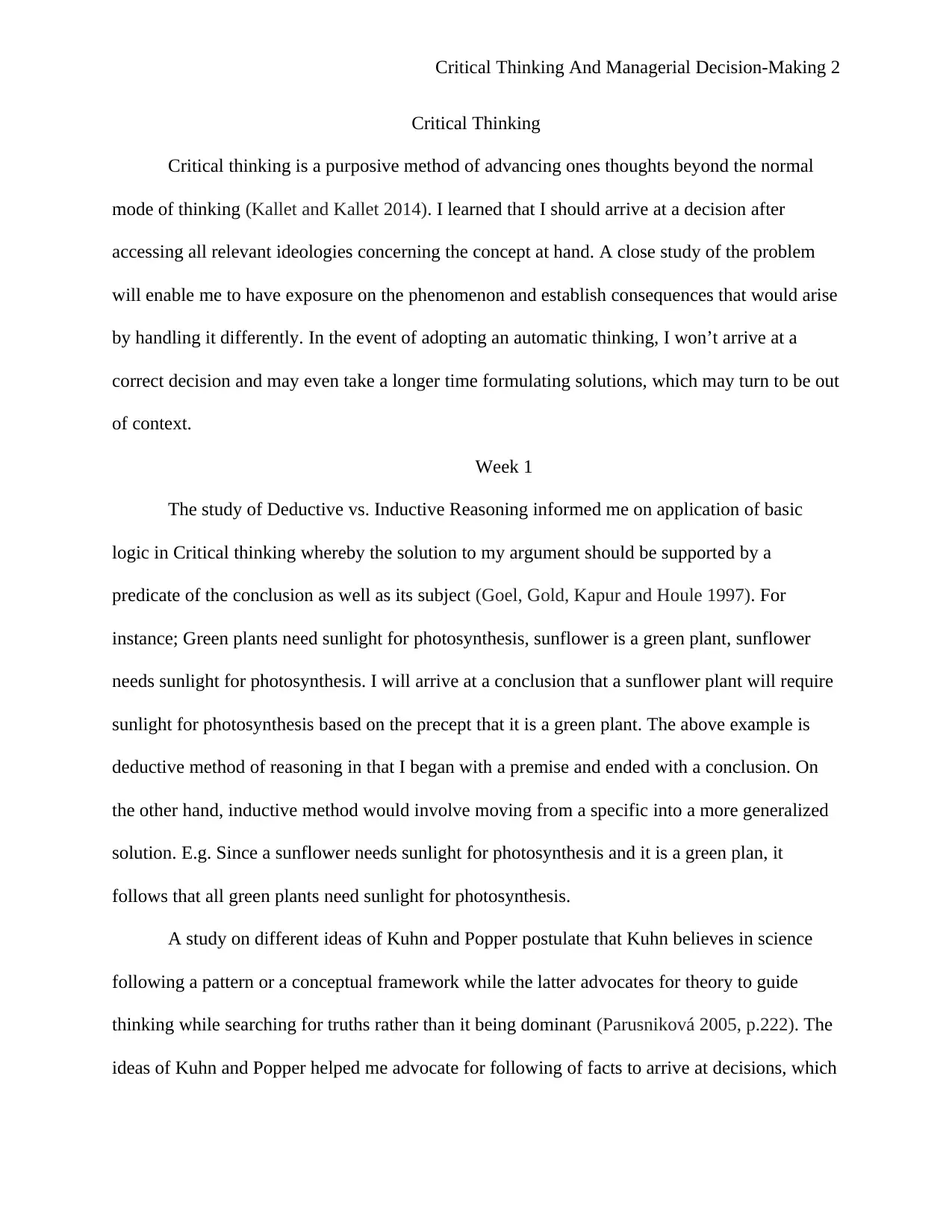
Critical Thinking And Managerial Decision-Making 2
Critical Thinking
Critical thinking is a purposive method of advancing ones thoughts beyond the normal
mode of thinking (Kallet and Kallet 2014). I learned that I should arrive at a decision after
accessing all relevant ideologies concerning the concept at hand. A close study of the problem
will enable me to have exposure on the phenomenon and establish consequences that would arise
by handling it differently. In the event of adopting an automatic thinking, I won’t arrive at a
correct decision and may even take a longer time formulating solutions, which may turn to be out
of context.
Week 1
The study of Deductive vs. Inductive Reasoning informed me on application of basic
logic in Critical thinking whereby the solution to my argument should be supported by a
predicate of the conclusion as well as its subject (Goel, Gold, Kapur and Houle 1997). For
instance; Green plants need sunlight for photosynthesis, sunflower is a green plant, sunflower
needs sunlight for photosynthesis. I will arrive at a conclusion that a sunflower plant will require
sunlight for photosynthesis based on the precept that it is a green plant. The above example is
deductive method of reasoning in that I began with a premise and ended with a conclusion. On
the other hand, inductive method would involve moving from a specific into a more generalized
solution. E.g. Since a sunflower needs sunlight for photosynthesis and it is a green plan, it
follows that all green plants need sunlight for photosynthesis.
A study on different ideas of Kuhn and Popper postulate that Kuhn believes in science
following a pattern or a conceptual framework while the latter advocates for theory to guide
thinking while searching for truths rather than it being dominant (Parusniková 2005, p.222). The
ideas of Kuhn and Popper helped me advocate for following of facts to arrive at decisions, which
Critical Thinking
Critical thinking is a purposive method of advancing ones thoughts beyond the normal
mode of thinking (Kallet and Kallet 2014). I learned that I should arrive at a decision after
accessing all relevant ideologies concerning the concept at hand. A close study of the problem
will enable me to have exposure on the phenomenon and establish consequences that would arise
by handling it differently. In the event of adopting an automatic thinking, I won’t arrive at a
correct decision and may even take a longer time formulating solutions, which may turn to be out
of context.
Week 1
The study of Deductive vs. Inductive Reasoning informed me on application of basic
logic in Critical thinking whereby the solution to my argument should be supported by a
predicate of the conclusion as well as its subject (Goel, Gold, Kapur and Houle 1997). For
instance; Green plants need sunlight for photosynthesis, sunflower is a green plant, sunflower
needs sunlight for photosynthesis. I will arrive at a conclusion that a sunflower plant will require
sunlight for photosynthesis based on the precept that it is a green plant. The above example is
deductive method of reasoning in that I began with a premise and ended with a conclusion. On
the other hand, inductive method would involve moving from a specific into a more generalized
solution. E.g. Since a sunflower needs sunlight for photosynthesis and it is a green plan, it
follows that all green plants need sunlight for photosynthesis.
A study on different ideas of Kuhn and Popper postulate that Kuhn believes in science
following a pattern or a conceptual framework while the latter advocates for theory to guide
thinking while searching for truths rather than it being dominant (Parusniková 2005, p.222). The
ideas of Kuhn and Popper helped me advocate for following of facts to arrive at decisions, which
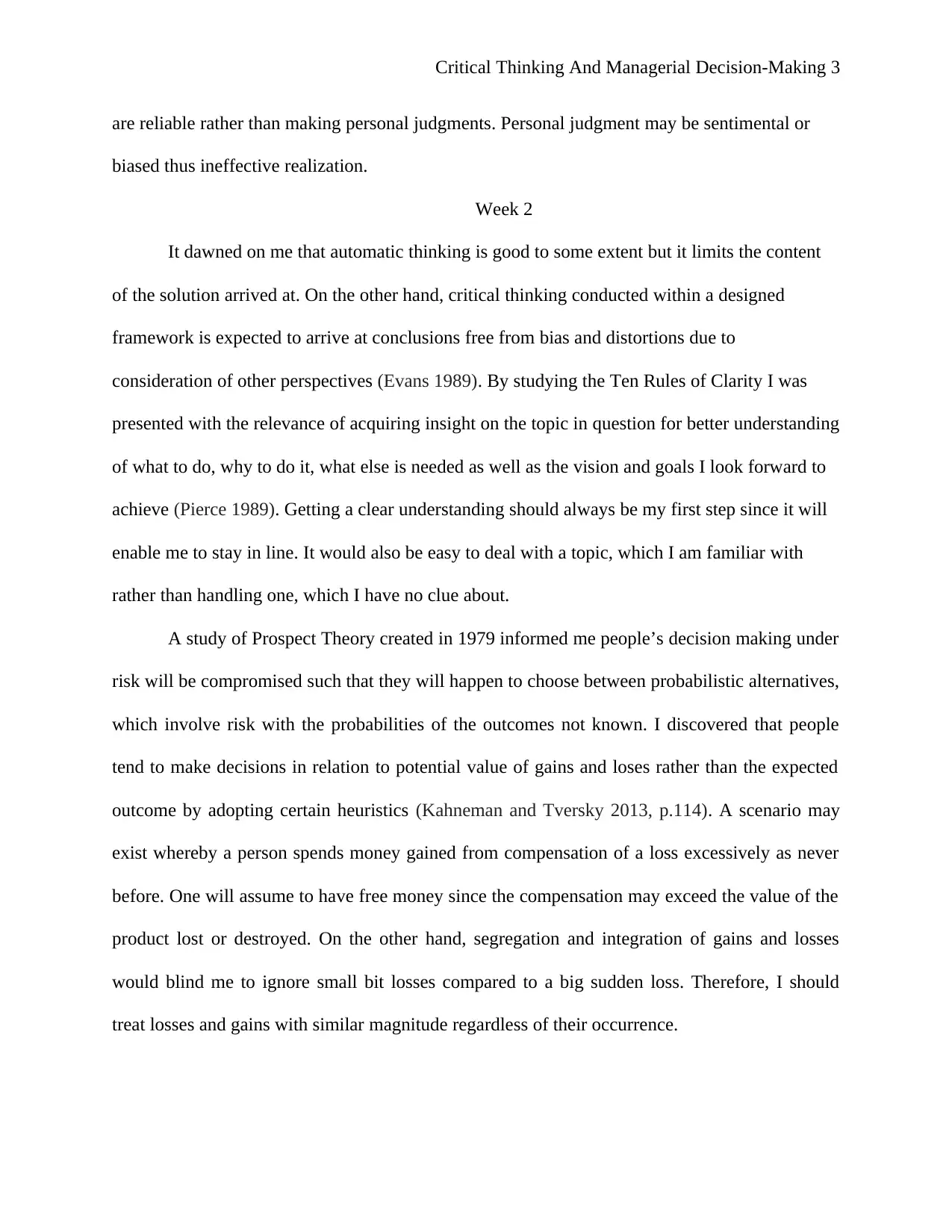
Critical Thinking And Managerial Decision-Making 3
are reliable rather than making personal judgments. Personal judgment may be sentimental or
biased thus ineffective realization.
Week 2
It dawned on me that automatic thinking is good to some extent but it limits the content
of the solution arrived at. On the other hand, critical thinking conducted within a designed
framework is expected to arrive at conclusions free from bias and distortions due to
consideration of other perspectives (Evans 1989). By studying the Ten Rules of Clarity I was
presented with the relevance of acquiring insight on the topic in question for better understanding
of what to do, why to do it, what else is needed as well as the vision and goals I look forward to
achieve (Pierce 1989). Getting a clear understanding should always be my first step since it will
enable me to stay in line. It would also be easy to deal with a topic, which I am familiar with
rather than handling one, which I have no clue about.
A study of Prospect Theory created in 1979 informed me people’s decision making under
risk will be compromised such that they will happen to choose between probabilistic alternatives,
which involve risk with the probabilities of the outcomes not known. I discovered that people
tend to make decisions in relation to potential value of gains and loses rather than the expected
outcome by adopting certain heuristics (Kahneman and Tversky 2013, p.114). A scenario may
exist whereby a person spends money gained from compensation of a loss excessively as never
before. One will assume to have free money since the compensation may exceed the value of the
product lost or destroyed. On the other hand, segregation and integration of gains and losses
would blind me to ignore small bit losses compared to a big sudden loss. Therefore, I should
treat losses and gains with similar magnitude regardless of their occurrence.
are reliable rather than making personal judgments. Personal judgment may be sentimental or
biased thus ineffective realization.
Week 2
It dawned on me that automatic thinking is good to some extent but it limits the content
of the solution arrived at. On the other hand, critical thinking conducted within a designed
framework is expected to arrive at conclusions free from bias and distortions due to
consideration of other perspectives (Evans 1989). By studying the Ten Rules of Clarity I was
presented with the relevance of acquiring insight on the topic in question for better understanding
of what to do, why to do it, what else is needed as well as the vision and goals I look forward to
achieve (Pierce 1989). Getting a clear understanding should always be my first step since it will
enable me to stay in line. It would also be easy to deal with a topic, which I am familiar with
rather than handling one, which I have no clue about.
A study of Prospect Theory created in 1979 informed me people’s decision making under
risk will be compromised such that they will happen to choose between probabilistic alternatives,
which involve risk with the probabilities of the outcomes not known. I discovered that people
tend to make decisions in relation to potential value of gains and loses rather than the expected
outcome by adopting certain heuristics (Kahneman and Tversky 2013, p.114). A scenario may
exist whereby a person spends money gained from compensation of a loss excessively as never
before. One will assume to have free money since the compensation may exceed the value of the
product lost or destroyed. On the other hand, segregation and integration of gains and losses
would blind me to ignore small bit losses compared to a big sudden loss. Therefore, I should
treat losses and gains with similar magnitude regardless of their occurrence.
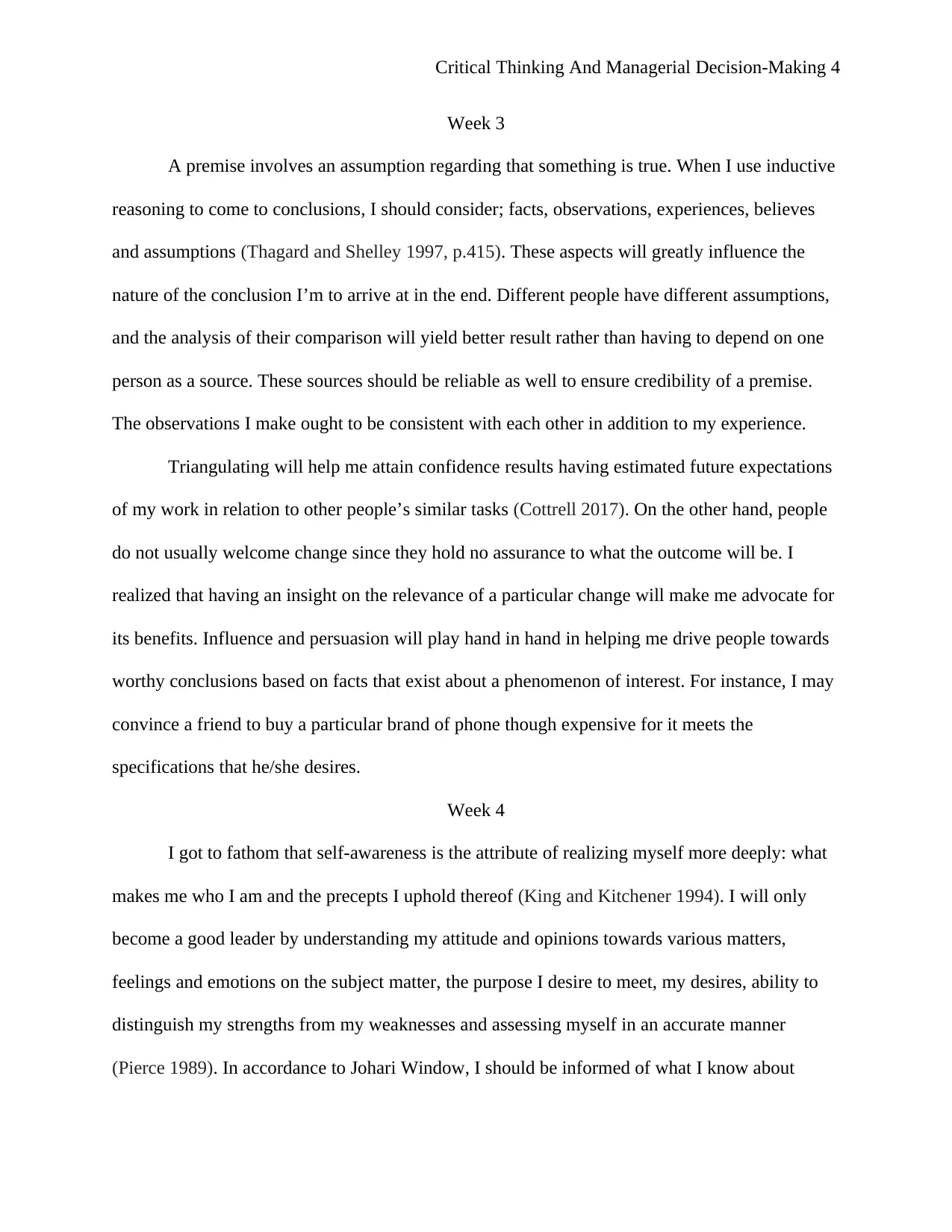
Critical Thinking And Managerial Decision-Making 4
Week 3
A premise involves an assumption regarding that something is true. When I use inductive
reasoning to come to conclusions, I should consider; facts, observations, experiences, believes
and assumptions (Thagard and Shelley 1997, p.415). These aspects will greatly influence the
nature of the conclusion I’m to arrive at in the end. Different people have different assumptions,
and the analysis of their comparison will yield better result rather than having to depend on one
person as a source. These sources should be reliable as well to ensure credibility of a premise.
The observations I make ought to be consistent with each other in addition to my experience.
Triangulating will help me attain confidence results having estimated future expectations
of my work in relation to other people’s similar tasks (Cottrell 2017). On the other hand, people
do not usually welcome change since they hold no assurance to what the outcome will be. I
realized that having an insight on the relevance of a particular change will make me advocate for
its benefits. Influence and persuasion will play hand in hand in helping me drive people towards
worthy conclusions based on facts that exist about a phenomenon of interest. For instance, I may
convince a friend to buy a particular brand of phone though expensive for it meets the
specifications that he/she desires.
Week 4
I got to fathom that self-awareness is the attribute of realizing myself more deeply: what
makes me who I am and the precepts I uphold thereof (King and Kitchener 1994). I will only
become a good leader by understanding my attitude and opinions towards various matters,
feelings and emotions on the subject matter, the purpose I desire to meet, my desires, ability to
distinguish my strengths from my weaknesses and assessing myself in an accurate manner
(Pierce 1989). In accordance to Johari Window, I should be informed of what I know about
Week 3
A premise involves an assumption regarding that something is true. When I use inductive
reasoning to come to conclusions, I should consider; facts, observations, experiences, believes
and assumptions (Thagard and Shelley 1997, p.415). These aspects will greatly influence the
nature of the conclusion I’m to arrive at in the end. Different people have different assumptions,
and the analysis of their comparison will yield better result rather than having to depend on one
person as a source. These sources should be reliable as well to ensure credibility of a premise.
The observations I make ought to be consistent with each other in addition to my experience.
Triangulating will help me attain confidence results having estimated future expectations
of my work in relation to other people’s similar tasks (Cottrell 2017). On the other hand, people
do not usually welcome change since they hold no assurance to what the outcome will be. I
realized that having an insight on the relevance of a particular change will make me advocate for
its benefits. Influence and persuasion will play hand in hand in helping me drive people towards
worthy conclusions based on facts that exist about a phenomenon of interest. For instance, I may
convince a friend to buy a particular brand of phone though expensive for it meets the
specifications that he/she desires.
Week 4
I got to fathom that self-awareness is the attribute of realizing myself more deeply: what
makes me who I am and the precepts I uphold thereof (King and Kitchener 1994). I will only
become a good leader by understanding my attitude and opinions towards various matters,
feelings and emotions on the subject matter, the purpose I desire to meet, my desires, ability to
distinguish my strengths from my weaknesses and assessing myself in an accurate manner
(Pierce 1989). In accordance to Johari Window, I should be informed of what I know about
Secure Best Marks with AI Grader
Need help grading? Try our AI Grader for instant feedback on your assignments.
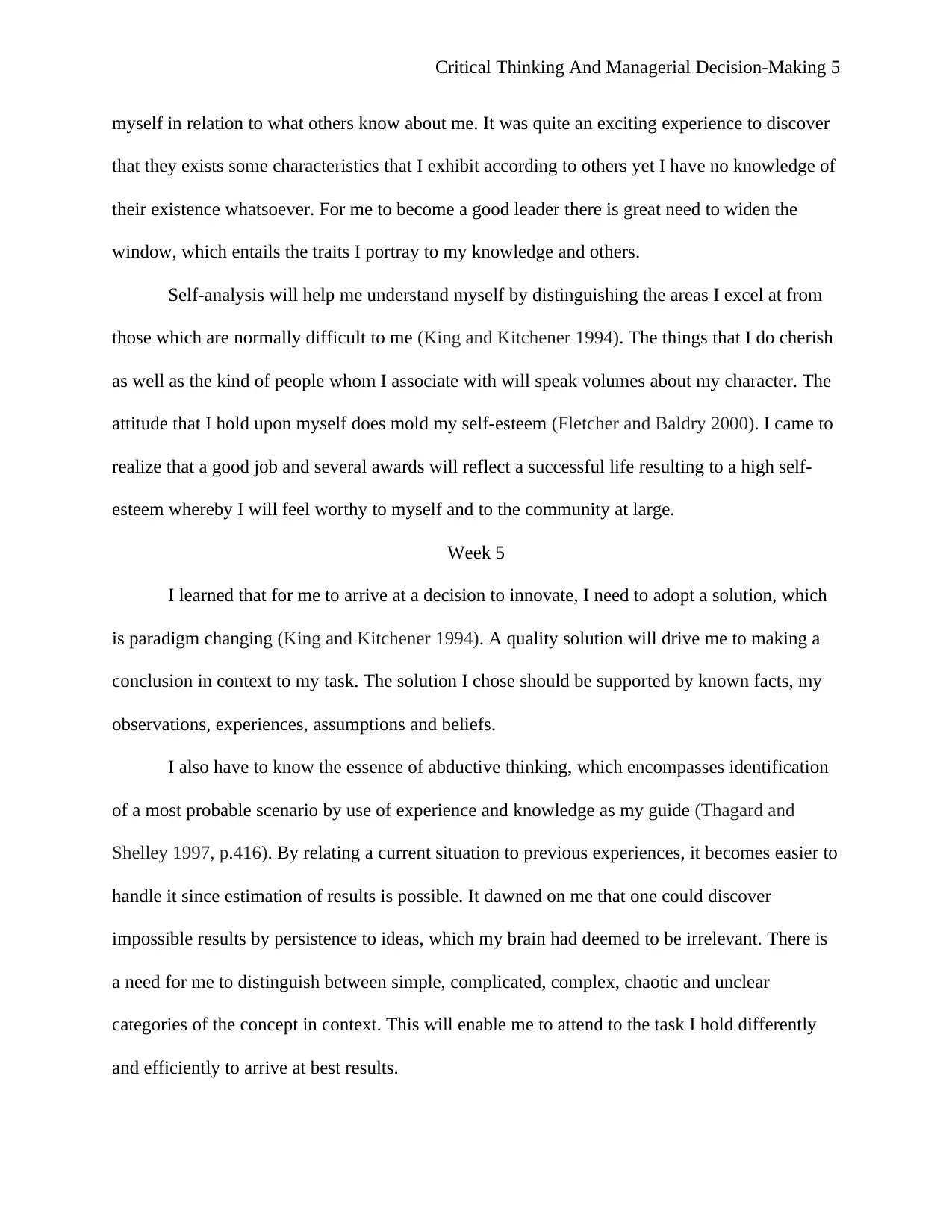
Critical Thinking And Managerial Decision-Making 5
myself in relation to what others know about me. It was quite an exciting experience to discover
that they exists some characteristics that I exhibit according to others yet I have no knowledge of
their existence whatsoever. For me to become a good leader there is great need to widen the
window, which entails the traits I portray to my knowledge and others.
Self-analysis will help me understand myself by distinguishing the areas I excel at from
those which are normally difficult to me (King and Kitchener 1994). The things that I do cherish
as well as the kind of people whom I associate with will speak volumes about my character. The
attitude that I hold upon myself does mold my self-esteem (Fletcher and Baldry 2000). I came to
realize that a good job and several awards will reflect a successful life resulting to a high self-
esteem whereby I will feel worthy to myself and to the community at large.
Week 5
I learned that for me to arrive at a decision to innovate, I need to adopt a solution, which
is paradigm changing (King and Kitchener 1994). A quality solution will drive me to making a
conclusion in context to my task. The solution I chose should be supported by known facts, my
observations, experiences, assumptions and beliefs.
I also have to know the essence of abductive thinking, which encompasses identification
of a most probable scenario by use of experience and knowledge as my guide (Thagard and
Shelley 1997, p.416). By relating a current situation to previous experiences, it becomes easier to
handle it since estimation of results is possible. It dawned on me that one could discover
impossible results by persistence to ideas, which my brain had deemed to be irrelevant. There is
a need for me to distinguish between simple, complicated, complex, chaotic and unclear
categories of the concept in context. This will enable me to attend to the task I hold differently
and efficiently to arrive at best results.
myself in relation to what others know about me. It was quite an exciting experience to discover
that they exists some characteristics that I exhibit according to others yet I have no knowledge of
their existence whatsoever. For me to become a good leader there is great need to widen the
window, which entails the traits I portray to my knowledge and others.
Self-analysis will help me understand myself by distinguishing the areas I excel at from
those which are normally difficult to me (King and Kitchener 1994). The things that I do cherish
as well as the kind of people whom I associate with will speak volumes about my character. The
attitude that I hold upon myself does mold my self-esteem (Fletcher and Baldry 2000). I came to
realize that a good job and several awards will reflect a successful life resulting to a high self-
esteem whereby I will feel worthy to myself and to the community at large.
Week 5
I learned that for me to arrive at a decision to innovate, I need to adopt a solution, which
is paradigm changing (King and Kitchener 1994). A quality solution will drive me to making a
conclusion in context to my task. The solution I chose should be supported by known facts, my
observations, experiences, assumptions and beliefs.
I also have to know the essence of abductive thinking, which encompasses identification
of a most probable scenario by use of experience and knowledge as my guide (Thagard and
Shelley 1997, p.416). By relating a current situation to previous experiences, it becomes easier to
handle it since estimation of results is possible. It dawned on me that one could discover
impossible results by persistence to ideas, which my brain had deemed to be irrelevant. There is
a need for me to distinguish between simple, complicated, complex, chaotic and unclear
categories of the concept in context. This will enable me to attend to the task I hold differently
and efficiently to arrive at best results.

Critical Thinking And Managerial Decision-Making 6
Week 6
Directors in a firm as well as fellow employees should be informed of the decision I
make as it serves the entire organization (Paul and Binker 1990). It would be impossible to make
a conclusion without consent of my superiors. All the necessary proceedings need to be followed
before making conclusions. Besides that, whatever ideas I hold will require finances for
actualizing them thus a requirement of consent from the funding committee.
The evaluation of risks enabled me to distinguish between upside risk and downside risk.
Upside risk can be avoided while downward risk is usually unpredictable. It should therefore be
my obligation to avoid making decisions which would cause a downward risk and be prepared to
deal with occurrences of downward risks.
Week 7
A summary of critical thinking emphasized further on the methods, reasons and relevance
of making correct decisions. I realized that there are several forms of decisions, which one
requires to make in day-to-day life (Fletcher and Baldry 2000, p.310). People will advise me on
my lifestyle decisions, but the ultimate decision remains to be mine. When it comes to an
organization, other people’s opinions really matter since this is a collective situation. It beats
logic to make a conclusion with no consent from corresponding higher authorities. Every
decision I make should be supported by facts (Phillips 1987). I should have the ability to
approximate my results in relation to previous outcomes achieved by others before on the same
subject matter. Paradigm in itself reflects confidence in expected results of a decision, as I am
able to stay tuned to the topic at hand.
Week 6
Directors in a firm as well as fellow employees should be informed of the decision I
make as it serves the entire organization (Paul and Binker 1990). It would be impossible to make
a conclusion without consent of my superiors. All the necessary proceedings need to be followed
before making conclusions. Besides that, whatever ideas I hold will require finances for
actualizing them thus a requirement of consent from the funding committee.
The evaluation of risks enabled me to distinguish between upside risk and downside risk.
Upside risk can be avoided while downward risk is usually unpredictable. It should therefore be
my obligation to avoid making decisions which would cause a downward risk and be prepared to
deal with occurrences of downward risks.
Week 7
A summary of critical thinking emphasized further on the methods, reasons and relevance
of making correct decisions. I realized that there are several forms of decisions, which one
requires to make in day-to-day life (Fletcher and Baldry 2000, p.310). People will advise me on
my lifestyle decisions, but the ultimate decision remains to be mine. When it comes to an
organization, other people’s opinions really matter since this is a collective situation. It beats
logic to make a conclusion with no consent from corresponding higher authorities. Every
decision I make should be supported by facts (Phillips 1987). I should have the ability to
approximate my results in relation to previous outcomes achieved by others before on the same
subject matter. Paradigm in itself reflects confidence in expected results of a decision, as I am
able to stay tuned to the topic at hand.
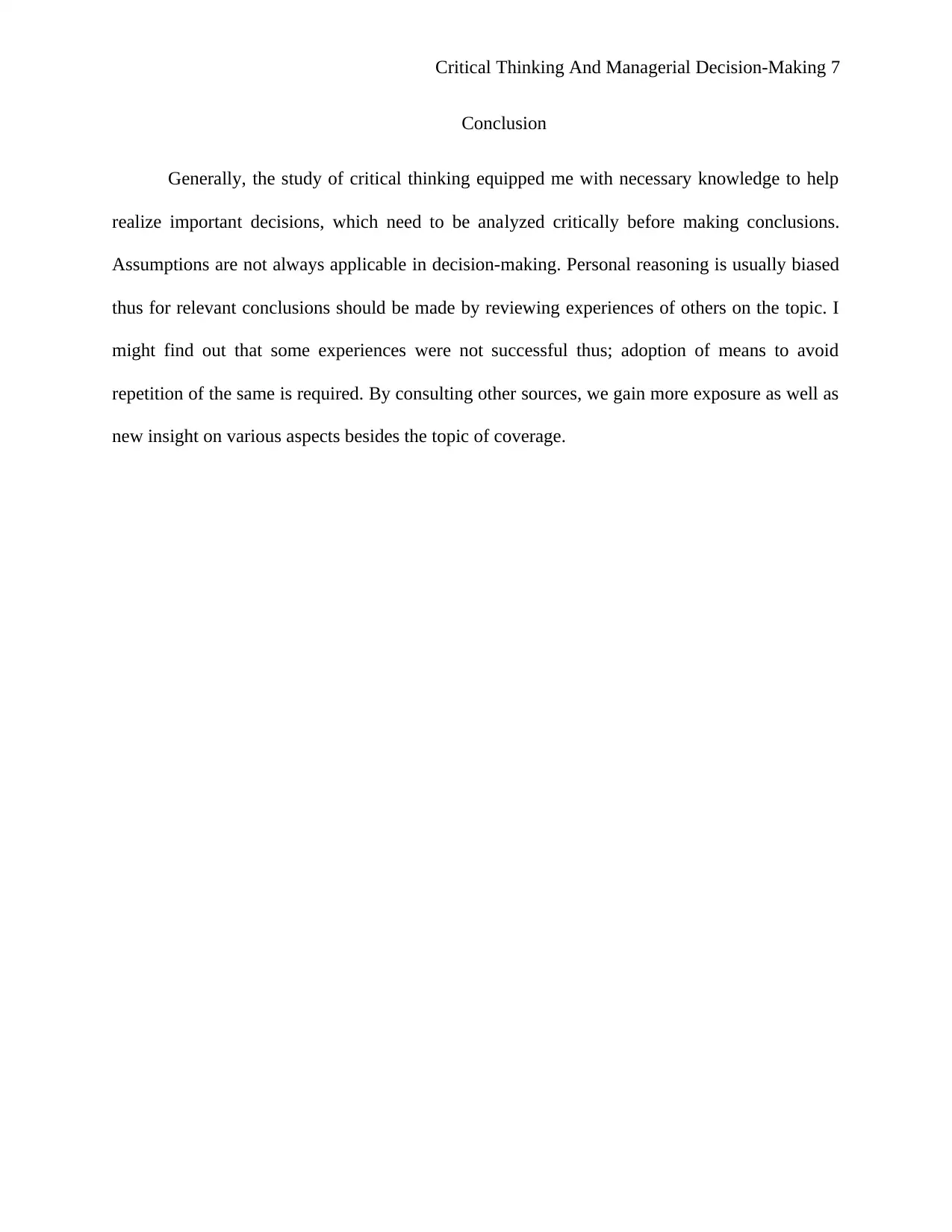
Critical Thinking And Managerial Decision-Making 7
Conclusion
Generally, the study of critical thinking equipped me with necessary knowledge to help
realize important decisions, which need to be analyzed critically before making conclusions.
Assumptions are not always applicable in decision-making. Personal reasoning is usually biased
thus for relevant conclusions should be made by reviewing experiences of others on the topic. I
might find out that some experiences were not successful thus; adoption of means to avoid
repetition of the same is required. By consulting other sources, we gain more exposure as well as
new insight on various aspects besides the topic of coverage.
Conclusion
Generally, the study of critical thinking equipped me with necessary knowledge to help
realize important decisions, which need to be analyzed critically before making conclusions.
Assumptions are not always applicable in decision-making. Personal reasoning is usually biased
thus for relevant conclusions should be made by reviewing experiences of others on the topic. I
might find out that some experiences were not successful thus; adoption of means to avoid
repetition of the same is required. By consulting other sources, we gain more exposure as well as
new insight on various aspects besides the topic of coverage.
Paraphrase This Document
Need a fresh take? Get an instant paraphrase of this document with our AI Paraphraser
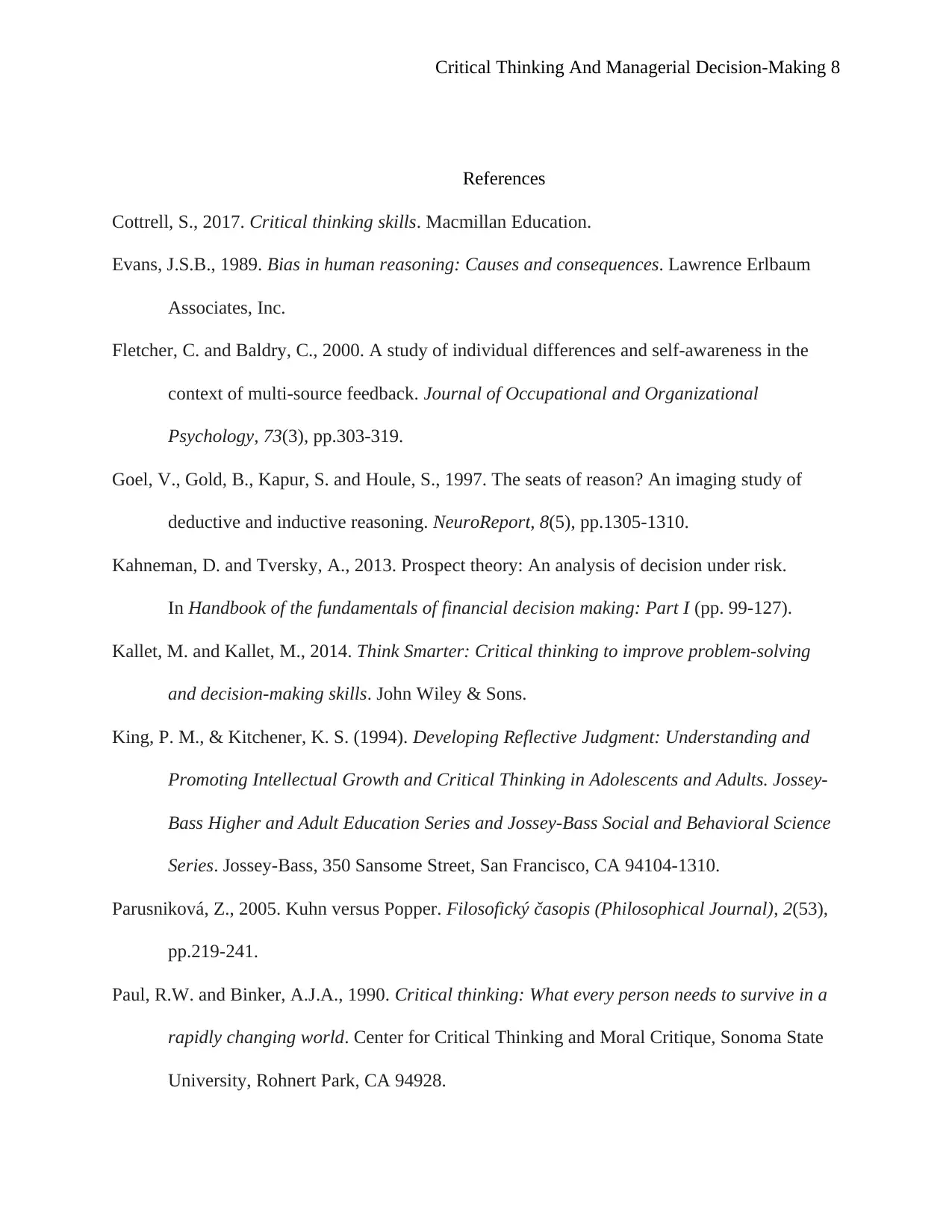
Critical Thinking And Managerial Decision-Making 8
References
Cottrell, S., 2017. Critical thinking skills. Macmillan Education.
Evans, J.S.B., 1989. Bias in human reasoning: Causes and consequences. Lawrence Erlbaum
Associates, Inc.
Fletcher, C. and Baldry, C., 2000. A study of individual differences and self‐awareness in the
context of multi‐source feedback. Journal of Occupational and Organizational
Psychology, 73(3), pp.303-319.
Goel, V., Gold, B., Kapur, S. and Houle, S., 1997. The seats of reason? An imaging study of
deductive and inductive reasoning. NeuroReport, 8(5), pp.1305-1310.
Kahneman, D. and Tversky, A., 2013. Prospect theory: An analysis of decision under risk.
In Handbook of the fundamentals of financial decision making: Part I (pp. 99-127).
Kallet, M. and Kallet, M., 2014. Think Smarter: Critical thinking to improve problem-solving
and decision-making skills. John Wiley & Sons.
King, P. M., & Kitchener, K. S. (1994). Developing Reflective Judgment: Understanding and
Promoting Intellectual Growth and Critical Thinking in Adolescents and Adults. Jossey-
Bass Higher and Adult Education Series and Jossey-Bass Social and Behavioral Science
Series. Jossey-Bass, 350 Sansome Street, San Francisco, CA 94104-1310.
Parusniková, Z., 2005. Kuhn versus Popper. Filosofický časopis (Philosophical Journal), 2(53),
pp.219-241.
Paul, R.W. and Binker, A.J.A., 1990. Critical thinking: What every person needs to survive in a
rapidly changing world. Center for Critical Thinking and Moral Critique, Sonoma State
University, Rohnert Park, CA 94928.
References
Cottrell, S., 2017. Critical thinking skills. Macmillan Education.
Evans, J.S.B., 1989. Bias in human reasoning: Causes and consequences. Lawrence Erlbaum
Associates, Inc.
Fletcher, C. and Baldry, C., 2000. A study of individual differences and self‐awareness in the
context of multi‐source feedback. Journal of Occupational and Organizational
Psychology, 73(3), pp.303-319.
Goel, V., Gold, B., Kapur, S. and Houle, S., 1997. The seats of reason? An imaging study of
deductive and inductive reasoning. NeuroReport, 8(5), pp.1305-1310.
Kahneman, D. and Tversky, A., 2013. Prospect theory: An analysis of decision under risk.
In Handbook of the fundamentals of financial decision making: Part I (pp. 99-127).
Kallet, M. and Kallet, M., 2014. Think Smarter: Critical thinking to improve problem-solving
and decision-making skills. John Wiley & Sons.
King, P. M., & Kitchener, K. S. (1994). Developing Reflective Judgment: Understanding and
Promoting Intellectual Growth and Critical Thinking in Adolescents and Adults. Jossey-
Bass Higher and Adult Education Series and Jossey-Bass Social and Behavioral Science
Series. Jossey-Bass, 350 Sansome Street, San Francisco, CA 94104-1310.
Parusniková, Z., 2005. Kuhn versus Popper. Filosofický časopis (Philosophical Journal), 2(53),
pp.219-241.
Paul, R.W. and Binker, A.J.A., 1990. Critical thinking: What every person needs to survive in a
rapidly changing world. Center for Critical Thinking and Moral Critique, Sonoma State
University, Rohnert Park, CA 94928.
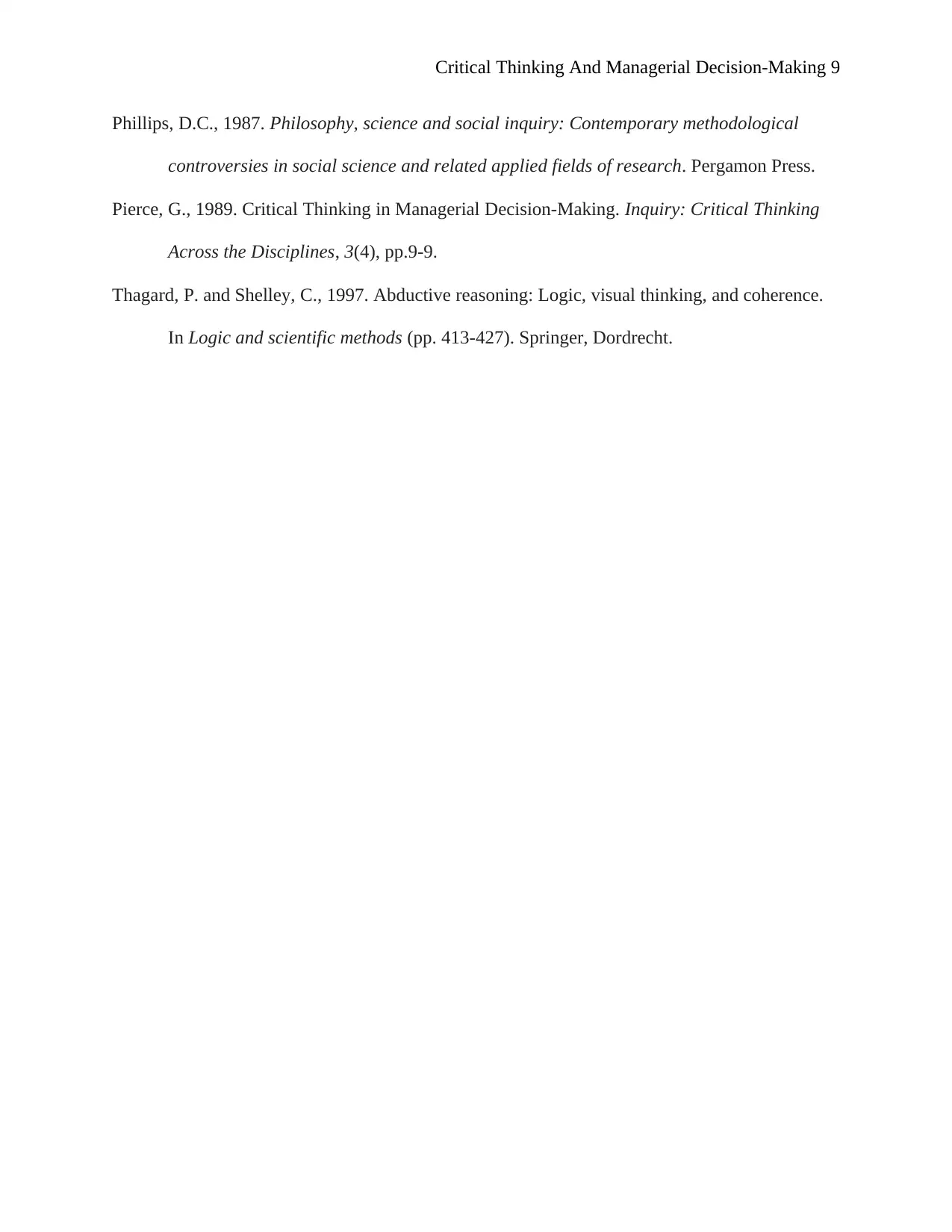
Critical Thinking And Managerial Decision-Making 9
Phillips, D.C., 1987. Philosophy, science and social inquiry: Contemporary methodological
controversies in social science and related applied fields of research. Pergamon Press.
Pierce, G., 1989. Critical Thinking in Managerial Decision-Making. Inquiry: Critical Thinking
Across the Disciplines, 3(4), pp.9-9.
Thagard, P. and Shelley, C., 1997. Abductive reasoning: Logic, visual thinking, and coherence.
In Logic and scientific methods (pp. 413-427). Springer, Dordrecht.
Phillips, D.C., 1987. Philosophy, science and social inquiry: Contemporary methodological
controversies in social science and related applied fields of research. Pergamon Press.
Pierce, G., 1989. Critical Thinking in Managerial Decision-Making. Inquiry: Critical Thinking
Across the Disciplines, 3(4), pp.9-9.
Thagard, P. and Shelley, C., 1997. Abductive reasoning: Logic, visual thinking, and coherence.
In Logic and scientific methods (pp. 413-427). Springer, Dordrecht.
1 out of 9
Your All-in-One AI-Powered Toolkit for Academic Success.
+13062052269
info@desklib.com
Available 24*7 on WhatsApp / Email
![[object Object]](/_next/static/media/star-bottom.7253800d.svg)
Unlock your academic potential
© 2024 | Zucol Services PVT LTD | All rights reserved.
